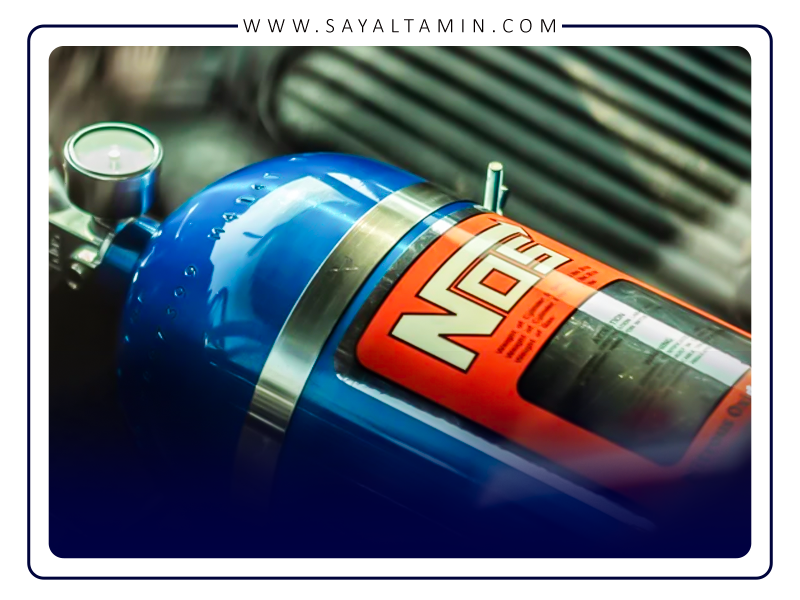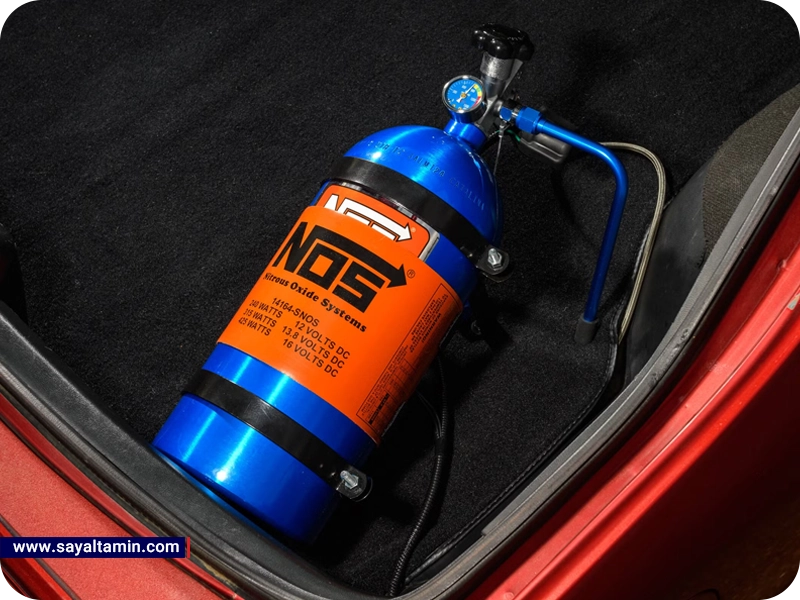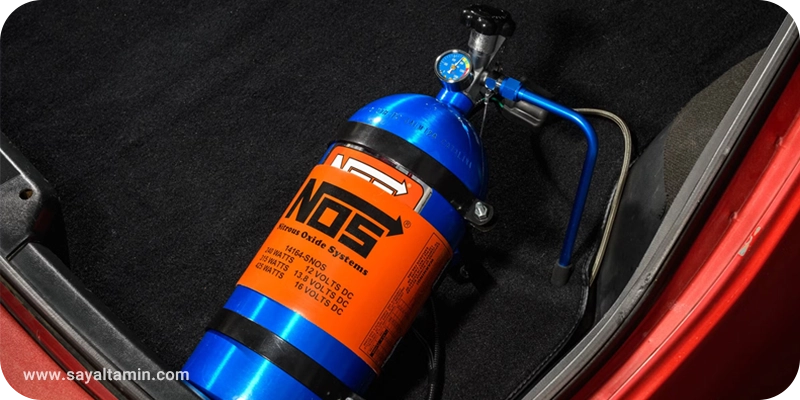This post is also available in: Persian
Nitrous oxide is used in cars, especially in racing, to increase acceleration and engine power. This term is the same as nitrogen oxide, which is also known as “nitro.” This gas is not a fuel that can be burned in a car engine to produce energy. This gas helps improve engine performance and efficiency by increasing oxygen supply to the engine. This supplement does the job of a turbocharger in cars, albeit in a more basic and temporary way.
What is nitrous oxide?
Nitrous oxide (N₂O), commonly known as “laughing gas”, is a chemical compound consisting of two nitrogen atoms and one oxygen atom. It is a colorless, odorless, and nonflammable gas. Despite being nonflammable, it is effective in enhancing fire flames due to its oxidizing properties. . This gas is in the main category of greenhouse gases and is an air pollutant. At room temperature, it is an inert gas with very low reactivity, and at a pressure of 50 atmospheres, it is stored as a liquid in special cylinders; however, as the temperature increases, the tendency to react in this compound also increases.

Properties and uses of nitrous oxide
Medical application:
Nitrous oxide is used as a sedative and analgesic in dentistry and some surgical procedures. It is worth noting that nitrous oxide is a weak anesthetic and must be combined with other drugs to achieve complete anesthesia. Different concentrations of nitrous oxide produce a range of different effects in anesthesia and anesthesia. This gas helps patients feel more comfortable during treatment and feel less pain. This gas is also used in natural childbirth to reduce labor pain. Things like low blood pressure, central nervous system stimulation, and consequences such as dizziness, headache, respiratory apnea, and gastrointestinal complications such as nausea are among the side effects of using nitrous oxide as an analgesic or anesthetic.
Automotive industry:
In racing cars, nitrous oxide is used as an additive to increase engine power. If this gas enters the car’s cylinder, it decomposes into nitrogen and oxygen atoms due to the high temperature inside the cylinder chamber and, through an exothermic reaction, significantly increases the temperature of the combustion chamber during the combustion reaction; this prevents the car’s engine from overheating. This gas also helps improve engine performance by increasing oxygen in the combustion chamber and increases the car’s acceleration. Of course, nitrous oxide gas is stored as a liquid gas in chambers under certain pressure conditions in the car’s engine.
Food industry:
Nitrous oxide is used in the production of whipped cream and as a preservative gas in some food products. It is also used in food and pharmaceutical packaging because of its protective properties against bacteria.
Environment: Nitrous oxide is known as a greenhouse gas and can contribute to climate change and global warming. This gas acts as a factor in increasing temperatures in the Earth’s atmosphere.
Chemical industries:
Nitrous oxide can be decomposed into nitrogen in chemical processes, usually in the presence of suitable catalysts, and the nitrogen produced can be used in various industries such as the production of ammonia, chemical fertilizers, and explosives.
It also produces nitric acid (HNO₃), a very important chemical used in the production of fertilizers, explosives, dyes, and pharmaceuticals. Nitrous oxide plays a role in the oxidation of ammonia to nitric acid. In this process, ammonia (NH₃) is first oxidized to nitric oxide (NO), and then nitric oxide is converted to nitrous oxide (N₂O), and finally to nitric acid.
This gas can act as a catalyst or component of a catalytic system in some chemical reactions.
1- Nitrous oxide can act as a mild oxidant in selective oxidation reactions. This property makes it useful in the oxidation of organic compounds such as alkenes, alcohols, and amines. For example, in the oxidation of alkenes to epoxides, nitrous oxide can act as an effective oxidant.
2- In some polymerization processes, nitrous oxide can act as a catalyst or reaction initiator. For example, in the radical polymerization of some monomers, nitrous oxide can act as a radical initiator and facilitate the initiation of the polymerization reaction.
3- Nitrous oxide can be used as a catalyst in the production of certain chemicals such as nitrogen compounds, epoxides, and other organic compounds. These chemicals are used in various industries such as pharmaceuticals, dyes, and the production of certain chemicals.)

Electronics industries:
A) Gas Purification: In the electronics industry, gas purification is a critical process because impurities, even in very small amounts, can negatively affect the performance of electronic devices.
b) Coolant: Nitrous oxide, due to its unique thermodynamic properties, can be used as an effective coolant in some cooling systems.
| Read more: Use of nitrous oxide in medicine and dentistry |
Entertainment industries:
Nitrous oxide (N₂O), also known as **laughing gas**, has applications in the entertainment industry and some illegal activities. The gas is used in some ceremonies and activities due to its psychoactive and invigorating effects. When inhaled, nitrous oxide produces short-term effects such as feelings of euphoria, relaxation, and uncontrollable laughter. These effects usually last between 1 and 5 minutes, which is why it is used as a recreational substance at parties and events.
Nitrous oxide is sometimes used illegally in sports. These uses are usually to enhance performance or reduce pain during athletic activities. Some athletes mistakenly believe that nitrous oxide can help increase oxygen delivery to the muscles, thereby improving their performance. This is incorrect, as nitrous oxide itself does not increase oxygen delivery. Nitrous oxide can temporarily reduce the feeling of pain and fatigue. Some athletes use this effect to endure greater pressure during training or competition. This is dangerous and can harm the person’s health. The use of nitrous oxide in professional sports is generally prohibited and is considered doping. Sports organizations such as the World Anti-Doping Agency (WADA) have banned the use of this substance in sports competitions.
Mechanism of action of nitrous in the engine
Nitrous Oxide Injection: When the driver activates the nitrous switch, nitrous oxide is transferred from the cylinder to the injection nozzles.
Nitrous oxide decomposition: At high temperatures in the combustion chamber, nitrous oxide decomposes and releases oxygen. This extra oxygen helps the fuel burn better.
Increased power: By increasing oxygen in the combustion chamber, more fuel can be burned, resulting in a significant increase in engine power.
Control and Safety: The driver can adjust the timing and amount of nitrous oxide injection using the control system. This helps prevent damage to the engine and its components. 
Types of nitrous injection systems
Dry injection: N₂O gas alone enters the breathing tube and the fuel system is adjusted to introduce additional fuel.
Wet injection: N₂O gas and additional fuel are first mixed together and injected into the breathing tube through a nozzle.
Direct injection: There is one injector per cylinder that sends N₂O gas and additional fuel into the combustion chamber. This is most commonly used in racing cars.
Main components of the nitrous system
Nitrous oxide cylinder: Nitrous oxide is stored in a pressurized cylinder. This cylinder is usually made of steel or resistant alloys and must be refilled periodically.
Pressure regulating valve: This valve controls the gas pressure and ensures that nitrous oxide is injected into the system safely and at the proper pressure.
Transfer tubes: The tubes that transport nitrous oxide from the cylinder to the injection system. These tubes must be resistant to pressure and temperature.
Injection nozzles: Nozzles that inject nitrous oxide into the combustion chamber. These nozzles are usually installed near the intake valves.
Control system: This system includes switches and sensors that allow the driver to control the timing and amount of nitrous oxide injection. Some systems operate automatically and adjust based on engine conditions.
Comparison with other methods of increasing strength
Nitrous oxide (N₂O):
Rapid Performance: Nitrous oxide provides a sudden increase in power, allowing the driver to accelerate faster at specific times, such as when starting a race or overtaking.
Easy to install: Nitrous systems are usually easy to install and can be added to a vehicle quickly.
Need for engine reinforcement: To prevent possible damage, engine parts may need to be reinforced.
Supercharger:
Continuous Performance: The supercharger continuously increases power, helping the engine perform better at all engine speeds.
Lower pressure and heat: In general, a supercharger puts less pressure and heat on the engine and can operate continuously.
Higher cost: Installing and maintaining a supercharger is usually more expensive than nitrous oxide.
Turbocharger:
Increasing power using exhaust gases: The turbocharger uses the engine’s exhaust gases to increase power, continuously increasing power.
Optimal performance at high revs: This system usually performs better at high revs and can continuously increase power.
Installation complexity: Installing a turbocharger is usually more complicated than nitrous oxide and requires precise adjustments.
Benefits of using nitrous in a car
Increased engine power: Nitrous oxide significantly increases engine power due to the increased oxygen in the combustion chamber.
Improved acceleration: By injecting nitrous oxide, the vehicle’s acceleration increases instantly, which is very important in racing.
Better performance in certain situations: In situations where more power is needed, nitrous oxide can act as an effective supplement.
Easy to install and operate: Nitrous oxide systems are usually easy to install and can add to the vehicle’s speed.
Safety and technical considerations
Engine Settings: To use nitrous oxide, the engine must be properly tuned to prevent possible damage.
Pressure and temperature: Nitrous oxide must be stored at the appropriate pressure and temperature to prevent it from turning into a liquid state.
Performance Monitoring: When using nitrous oxide, the driver should pay attention to engine speed and vehicle condition to avoid problems.
Use of high octane fuel and ignition timing: This is essential to prevent engine knocking.

Challenges and limitations
Nitrous oxide in cars can have challenges and limitations. These include the high pressure and heat it puts on the engine and the possibility of damage to its components. Also, the need to strengthen engine parts and use the system correctly are also limitations of this technology. But in general, nitrous oxide systems put a lot of pressure on the engine and its components and create high heat, as well as a lot of stress and impact on the engine when it is activated. Connecting rod and crankshaft breakage, piston burnout and damage, melting and dimensional changes in valve stems, high pressure on the unboosted exhaust system, explosion and leakage of nitrous oxide capsules, etc. are some of the concerns that arise if an uncalculated nitrous oxide injection system is installed.
| Must read: Cryogenic storage tanks |
The future of nitrous oxide in automotive applications
Technological Development: As technology advances, nitrous oxide systems will improve and become more efficient. This means designing smarter and more efficient systems to manage nitrous and fuel injection.
Cost reduction: As production and market competition increase, the costs associated with installing and maintaining nitrous oxide systems may decrease, which could provide greater access to this technology.
Environmental Concerns: With increasing concerns about pollution and climate change, more research may be conducted into the use of nitrous oxide as a cleaner and more efficient solution in vehicles.
Use in electric vehicles: Nitrous oxide may be used as a supplement for electric vehicles in the future to help increase their power and performance.
Laws and regulations: Changes in laws and regulations regarding the use of nitrous oxide in vehicles could affect the future of this technology. New standards for safety and efficiency may be required.
Nitrous oxide is known as a quick and effective way to increase engine power, but it can put more strain and heat into the engine. In contrast, superchargers and turbochargers continuously increase power and usually put less strain and heat into the engine, but they are more expensive and complex. The choice between these methods depends on the specific needs and conditions of each driver and vehicle.
————————————————–
Sources:



